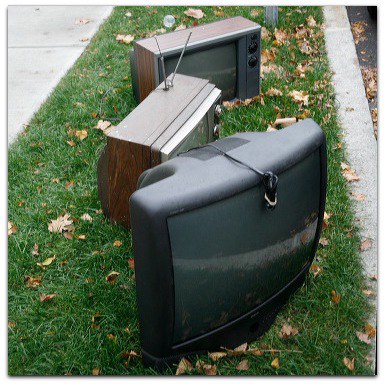 I’m sitting in a medical office (routine stuff) where a number of people, myself included, are doing our best to ignore the flat TV screen on the wall. Most of us are reading magazines, using our phones or tablets, or (in one case — mine) working on a laptop.
I’m sitting in a medical office (routine stuff) where a number of people, myself included, are doing our best to ignore the flat TV screen on the wall. Most of us are reading magazines, using our phones or tablets, or (in one case — mine) working on a laptop.
When I arrived around 8am, I found the flat screen interesting, because it was showing a radio show I like: Dennis & Callahan, of WEEI. While most sports talk shows sound like human beer cans yelling at each other, D&C is always thoughtful and informative, even (or especially) when it veers off the sports groove, as it often does. I’d never seen John Dennis or Gerry Callahan before, so it was interesting to see them at work. I also like their long 8am conversation with Boomer Esiason every Monday during the NFL season. So digging all that was cool. Then, at 9am, when the show ended, the first of a series of half-hour-long ads began to run. Says here on the NESN schedule page that “paid programming” will continue until noon. Nobody in the room is watching. It wouldn’t be a stretch to say that most of them find the non-stop pitches annoying.
NESN is the New England Sports Network. I’d never seen it before, except maybe in a bar or another place like this one. Nothing I’ve seen so far this morning would make me want to see it again. (I’m still in the Waiting Room, waiting.) While it was nice seeing D&C, I don’t need a TV for that. And, while “paid programming” fills the time between D&C and sports news later in the day, it’s otherwise one big value-subtract for everybody but the station and the advertiser (and, I suppose the people who buy the crap being advertised — currently some kind of electronic “Amish fireplace.”). But then, so might be pretty much everything else on TV that isn’t news or sports you can’t get anywhere else.
That’s being unfair, of course. There is plenty of worthwhile stuff on TV. Talent shows. Sit-coms. Dramas and comedies. Even some reality shows. (I know people who love “Dancing With the Stars.”) My point is that none of it needs to be on TV, because today TV = Cable, and only Cable needs Cable. What we call “channels” and “networks” are just sources of programs, most of which are just files or streams that can be stored as files. We have the Net for that now.
Programs should be made available to pay for and watch on an a la carte basis, or as part of subscription packages that make sense to viewers. Apple does some of that, but most of the programs are too expensive at this point.
Sure, NBC, ABC, TNT, AMC and the rest of them have “brands” as sources of programs. But why should they be stuffed inside so much packing material, like D&C gets stuffed between “paid programming” nobody watches? Why not buy what’s worth more than $zero at prices that also exceed $zero, without also buying all the pure crap that serves as filler?
Mostly because the flywheels of Business As Usual in TV are enormous, and are sustained by FCC regulations for over-the-air, Cable and Satellite (a variety of Cable) that remain anchored in the nearly-vanished Antenna Age. (Speaking of which, there is an excellent exhibition called TV in the Antenna Age, in Terminal 3 at SFO. Check it out if you’re flying United in or out of there.)
Conveniently, all Cable companies offer Internet service as well. TV on the Net they call “over the top.” But in the long run, “over the top” will be the whole thing. The writing is already on the wall. Progress toward the inevitable is slow, but we can see how it ends. What used to be TV will just be files and streams, some of which we’ll pay for, and some of which will be free. Meanwhile, more of the usual crap will just be ignored.
[Later…] Brett (below) makes a good point about the high efficiency of broadcast (cable) for streaming. I should add that cable broadcast as a way of delivering video will make sense for a long time. But the business and technical model as it stands is obsolete and out of alignment with the marketplace. “TV” will become as obsolete as telegraphy. Video will never be.
Leave a Reply